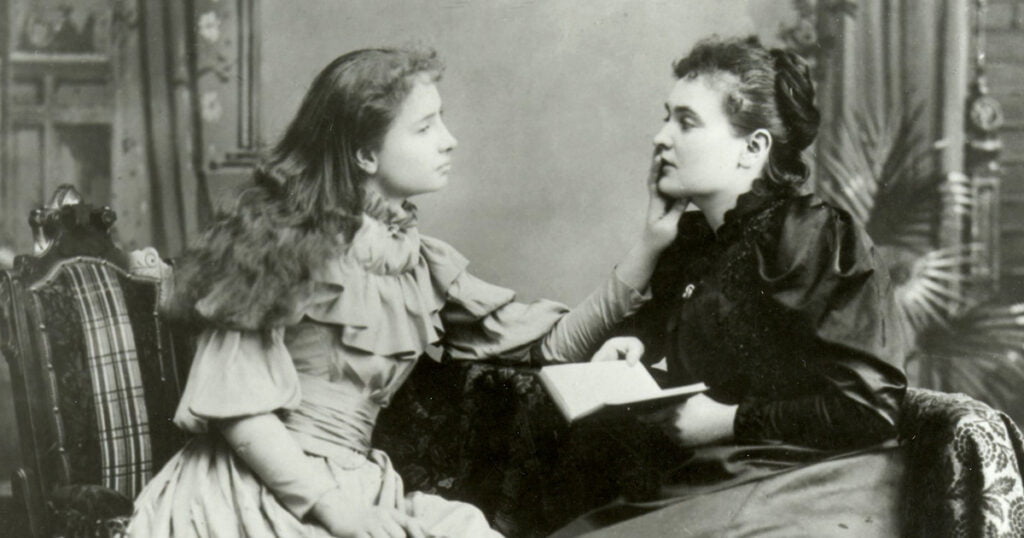Somewhere in the world, someone just became blind—or they were born blind. This person will grow up, make friends, and likely live a happy and fulfilling life. But they will surely have moments where they reflect upon their luck: “Why did it have to be me?”
Somewhere else in the word, another innocent child just lost their sense of hearing. They will also grow up and probably struggle with the same sorts of questions: “What are the chances that this happened to me? Why not someone else?”
And then you have Helen Keller.

Helen Keller’s Story
Helen Adams Keller was born in 1880 in the small southern town of Tuscumbia, Alabama. Before she was even two years old (19 months), she became both blind and deaf.
Through the work of some amazing teachers, Helen learned how to read and eventually even how to speak. Really try to imagine the challenge of learning how to read and speak when you can’t see or hear!
In her adult life, she came to enjoy a steady career as both a writer and a teacher.
Many people know of Helen Keller simply as the woman who was blind and deaf. But it can be argued that it wasn’t just her statistical unluckiness that made her so well-known.
The real reason the story of Helen Keller is so remarkable and so famous is because she wasn’t defeated by her circumstances—she rose above them and lived a life of astounding triumph and success.
Facts About Helen Keller
#1. Helen Keller became blind and deaf when she was only 19 months old. At this age, it’s safe to say that adult Helen had absolutely no memory of experiencing sights or sounds. This makes her eventual achievements even that much more impressive.
#2: Doctors in the 1800s didn’t know enough to figure out exactly what caused Helen’s blindness and deafness—but there have been some pretty good guesses. Doctors today believe her fateful illness was either scarlet fever, rubella, encephalitis, or, most likely, bacterial meningitis.
#3: While it’s assumed that Helen Keller was completely or profoundly deaf, it’s possible that she did have some sort of residual hearing, as many legally deaf people today do. This would simply mean that Helen was vaguely aware of extraordinarily loud sounds like thunder, factory machinery, or gunshots.
#4: Helen Keller learned to communicate through more than just one method. She could read through braille and raised words on cardboard, and she could even “read lips” by feeling the lips and throat of the person speaking. Astoundingly, she even learned to speak for herself through tedious training and practice.
#5: The first word that Helen Keller learned to read was “water.” As the famous story goes, Helen initially had tons of trouble learning how to read. After all, how would a young girl know to associate random felt symbols with specific objects in the world? But when her teacher presented the word “water” and simultaneously brought Helen out to the water pump to feel the real thing for herself, it all clicked.
As Helen herself recalled, “I knew then that ‘w-a-t-e-r’ meant the wonderful cool something that was flowing over my hand. That living word awakened my soul, gave it light, hope, joy, set it free.”
#6: Are you ready to feel like an underachiever? Helen Keller eventually learned how to read five different languages, including Latin, French, and German. How many can you speak, again?
#7: Helen Keller once piloted a plane. Yes, you read that right. In 1946, she had the opportunity to spend 20 minutes at the controls of a small airplane traveling from Rome to Paris. She communicated with the plane’s pilot through her companion Polly Thomson, who relayed the instructions to Helen.
Thomson said of the experience, “The plane crew were amazed at her sensitive touch on the controls. There was no shaking or vibration. She just sat there and flew the plane calmly and steadily.”
#8: Are you ready to feel like an underachiever again? Throughout her life, Helen Keller wrote and published 12 books and around 400 shorter essays and papers. Many of her books were about her own life experiences, but she also wrote about other contemporary topics relevant to her era.
She wrote her books in braille using a braille writer, which was the equivalent of a typewriter for blind people.
#9: Helen Keller attended multiple schools during her lifetime—both special needs schools and regular schools. She learned braille at the Perkins Institution before attending the Horace Mann School for the Deaf (where she learned to speak).
She then went to New York City to study at the Wright-Humason School for the Deaf, and two years later, moved to Massachusetts to attend the Cambridge School for Young Ladies. Finally, in 1900 she was admitted to Radcliffe College, and ended up graduating cum laude four years later.
#10: When she was 28, Helen Keller joined the American Socialist Party. Throughout her life, she was extremely active politically, campaigning for a variety of groundbreaking and progressive (at the time) causes. She was a strong supporter of birth control legalization and abortion, and women’s rights in general.
#11: Helen Keller was obsessed with dogs. She was reportedly almost always surrounded by dogs, as they brought her immense joy. Of course, she wasn’t able to appreciate dogs in the way seeing and hearing people can—by watching them bounce around and hearing their barks—but she had her own intimate way of connecting with them through touch and connection.
#12: After Helen Keller completed a speaking tour through the country of Japan, the locals were so inspired that the government gifted Helen a loyal Akita dog. The puppy was named “Kamikaze-Go,” and he bonded with Helen instantly.
Helen said of the dog, “If I cried from loneliness for my beloved teacher, he would put his big paw on my knee and press his cool nose against my cheek and lick away the tears.”
#13: From the time she was seven years old until she died, Helen Keller met every single U.S. president who held office. That’s 13 presidents!
Here’s the full list: Grover Cleveland, William McKinley, Theodore Roosevelt, William Howard Taft, Woodrow Wilson, Warren G. Harding, Calvin Coolidge, Herbert Hoover, Franklin Delano Roosevelt, Harry Truman, Dwight D. Eisenhower, John F. Kennedy, and Lyndon B. Johnson.
#14: When she was 36 years old, Helen Keller planned a scheme in which she would elope (run away to get married) with her secretary Peter Fagan. Fagan was a fellow writer himself, and he and Helen were fluent in communication with one another.
Helen’s mother ended up putting a stop to the whole plan, which seemed a little controlling, as Helen was almost 40 years old at this point! At the time, however, disabled people were generally not encouraged to get married and have children.
#15: Helen Keller was about 5 feet 6 inches tall, which put her about two inches above the national average female height.
#16: Helen Keller was nominated for the Nobel Peace Prize in 1954 after returning from a trip to the Middle East, where she advocated for the rights of blind and deaf people. Her legacy lives on in Jerusalem, where the aptly named Helen Keller School is still active in education and rehabilitation efforts.
#17: Helen Keller passed away in her own home in Connecticut at 3:35 p.m. on June 1, 1968. She lived to be 87 years old, which is impressive even by today’s standards. She died simply of old age, painlessly and peacefully. According to her caretaker, Mrs. Winifred Corbally, “She drifted off in her sleep. She died gently.”
#18: Helen Keller’s ashes were laid to rest in the crypt of the Washington National Cathedral in Washington, D.C., only a few feet away from where President Woodrow Wilson similarly lies. Her teacher Anne Sullivan Macy’s remains are adjacent to Helen’s, symbolizing even in death the inseparable bond that the two had in life.
#19: Helen Keller Day is a U.S. holiday held annually on Helen’s birthday, June 27th.
#20: In 2008, the electronic music duo 3OH!3 released a song called DONTTRUSTME, in which they sing the lyrics, “Shush girl, shut your lips. Do the Helen Keller and talk with your hips.” The song is obviously making light of Helen’s disabilities, and as such, is widely regarded as offensive.
Final Thoughts
Believe it or not, this list of 20 facts about Helen Keller has only scratched the surface of all the amazing things she achieved throughout her life.
Feel free to keep researching on your own to learn even more about this remarkable woman—you will certainly find no shortage of inspiration!
Share this post with your friends using these one-click sharing options:
👉 Click here to share on Facebook.
👉 Click here to share on X.
👉 Click here to share on LinkedIn.

Get the latest interviews, tips and guides in your inbox.